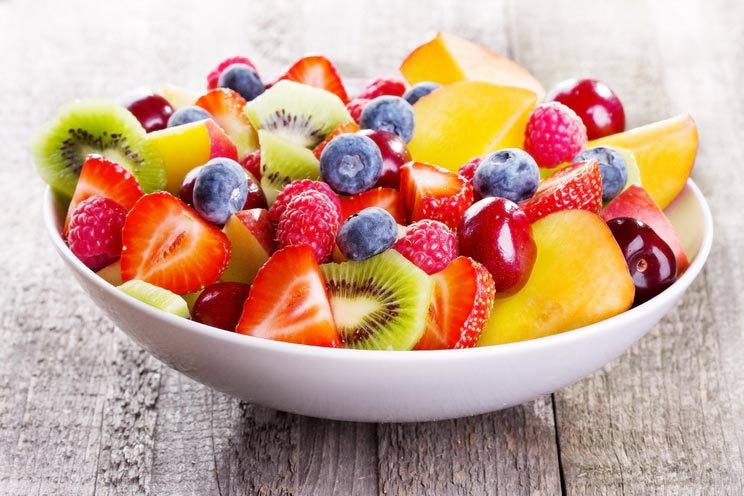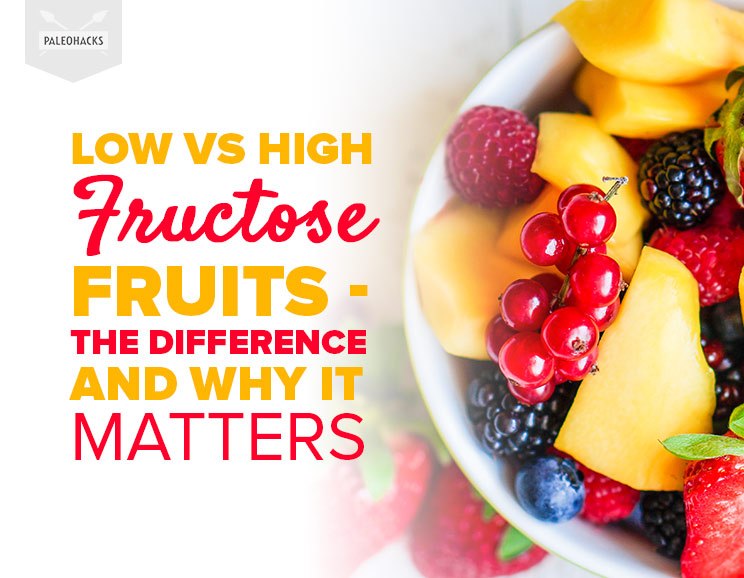Before you enjoy a big bowl of fruit salad as your next dessert, find out which varieties are high in fructose – and why it matters.
Everyone knows that too much sugar can be detrimental to your health. Even Paleo-friendly sweeteners, like honey or maple syrup, should be used only in moderation.
But fruit is a tricky subject. Are bananas, apples, and oranges a good Paleo snack, or simply too much sugar?
Suffering from Diabetes or blood sugar imbalance?
Grab our FREE Diabetes Guide & 7 Day Meal Plan here!
Nutrients in Fruit
Fruits are often loaded with vitamins, minerals, and antioxidants, which help to fight inflammation and the oxidation that causes cellular damage. Most fruits also contain a good amount of fiber, which is necessary for a healthy gut and proper elimination.
It’s important to know that certain fruits contain different forms of natural sugars, and these can affect how your body handles it during the digestion process. The two primary types of sugar found in fruits are fructose and glucose.
5 Negative Health Effects of Fructose

Fructose is typically the main source of fruit sugar whereas glucose is more often found in carbohydrate-rich foods like vegetables. Fructose tends to have more negatively associated health impacts, such as an increased risk for weight around the midsection which is considered to be the most dangerous kind. (1)
Here are five common risks of consuming too much fructose.
1. Body Fat
When the body receives glucose, it is quickly processed and sent out to the cells for energy usage. When fructose is eaten, however, a large percentage of it gets converted directly to fat and stored in the cells because glucose is the preferential carb fuel of the body. (2) This can be a direct cause of weight gain.
2. Insulin Resistance and Diabetes
The fructose-to-fat conversion can also tend towards insulin resistance, where the body becomes less responsive to insulin’s attempts to take glucose into the cells, and can even contribute to the development of type 2 diabetes. (3,4)
This is closely associated with fructose leading to weight gain since being overweight can independently disrupt ghrelin and leptin, the hormones that regulate appetite. (5)
3. Cardiovascular Disease
Fructose has been targeted as a potential cause for heart problems since it increases triglycerides and other risk factors. An excess of fructose can also increase the size of LDL particles in the blood, which, when oxidized, can lead to the narrowing of arteries. (6,7)
4. Liver Toxicity
Similar to excessive alcohol intake, too much fructose can induce liver damage by altering metabolism and hormone signaling. (8) When too much fruit is eaten, it can be converted to fatty deposits in the liver, reducing the liver’s ability to function and leading to digestive and detox-related problems.
5. Sugar Addiction
All forms of sugar can come with a hefty side of cravings, but fructose can be especially addictive. This is because fructose affects hormone levels in the brain that are associated with appetite, and can lead to decreased feelings of satiety after meals. (9) This is particularly important, as it is estimated that as much as 10 percent of our daily calories come from fructose sources alone. (10)
Too much sugar, even from fruit, can spike blood sugar and lead to destructive impacts on teeth, gum disease, LDL cholesterol, blood pressure, inflammation, and more. (11,12,13)
So Is Fruit Unhealthy?

The US Dietary Guidelines recommend one and a half to two cups of fruit daily for men and women who are ages 19 and up. (14) Every form of fruit counts as an actual cup, whether it be canned, frozen, or as 100 percent fruit juice, with the exception of dried fruit, which should be limited to a half cup daily.
The problem with these dietary guidelines is that all forms of fruit are considered equal when certain types and varieties can influence digestion, blood glucose, and even weight differently. Fruit juice, for example, contains little to no fiber and smacks a walloping punch of sugar when compared to consuming a whole piece of fruit.
These guidelines also do not differentiate between fructose or glucose, which should be considered by individuals who could be more sensitive to the effects of fructose, such as those with: (15,16,17,18)
- Type 2 diabetes
- Metabolic syndrome or insulin resistance
- Fructose intolerance
- Cardiovascular disease or high blood pressure
- Thyroid disease
- Hormone imbalances
- Fatty liver disease
Fructose Levels in Fruits

So how do you know which fruits to eat, and how much is a healthy amount?
As a rule, fruits that are higher in glucose than fructose are digested more easily. These are also less problematic for people with insulin, glucose, hormone, or weight problems.
The following list of fruits shows grams of fructose per 1 cup servings:
- Limes: 0g
- Lemons: 0g
- Cranberries: ½g
- Raspberries: 3g
- Clementine: 3g
- Blackberries: 3½g
- Strawberries: 4g
- Nectarine: 5g
- Peach: 6g
- Banana: 7g
- Blueberries: 7½g
- Medjool dates: 8g
- Apple: 9½g
- Pear: 12g
- Grapes: 12½g
- Mango: 32g
So how much can you eat? Some research shows that 25 to 40 grams of fructose daily is acceptable. (19) However, it might be more reasonable to keep your daily fruit intake locked into a 5:1 ratio of vegetables to fruit. For example, if you eat five cups of vegetables, you can then eat one cup of fruit.
By making your fruit intake dependent on your vegetables, you won’t over-consume fructose, and you’ll be getting plenty of glucose-based carbs and fiber that helps the body better handle all forms of sugar.
Bottom Line
Fructose is a simple form of sugar that can be difficult to digest in large amounts, leading to problems with insulin sensitivity, hormone balance, and cardiovascular disease.
While fruit should be included as part of a healthy and balanced diet, it’s important to remember that sugar in any capacity should be limited. Be aware of which fruits are highest in fructose and remember to eat plenty of vegetables to help offset the risks.

(Read This Next: Sugar: Is It a Drug?



 Creamy Almond Butter Cake Recipe
Creamy Almond Butter Cake Recipe








Show Comments